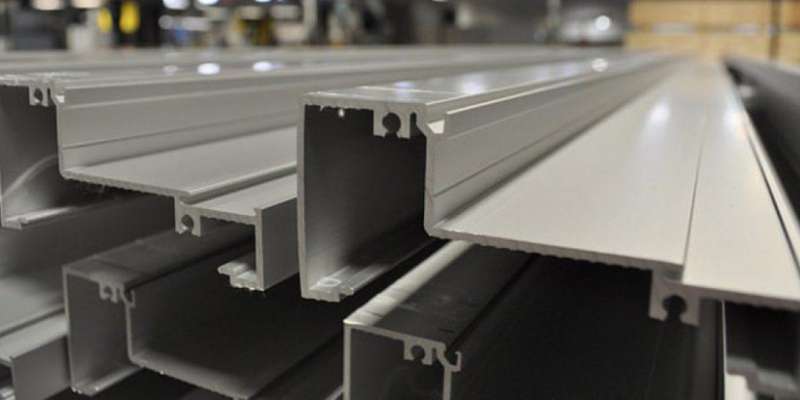- November 4, 2022
In recent years, aluminum extrusion has remained an essential aspect of product innovation and production. It is a significant part of our daily life as manufacturers use this process to make different components for homes, workplaces, and many more.
Even though extruded aluminum parts are used everywhere, many people hardly notice them. Aluminum extrusion has various applications in various industries due to its remarkable features. This article will discuss aluminum extrusion, its techniques, advantages and disadvantages, and key considerations for extrusion design. Let’s get to it!
What is Aluminum Extrusion?
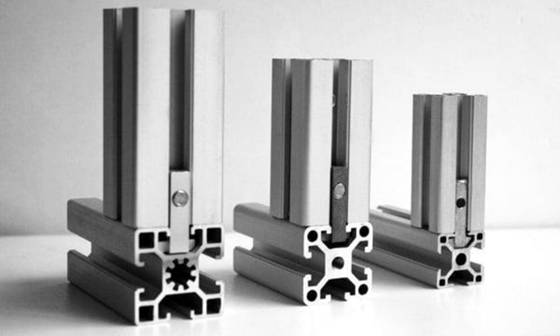
Aluminum extrusion involves heating and pushing aluminum alloy through a die with a predesigned cross-sectional shape. A firm ram pushes the aluminum through the die and pulls it along a runout table during the operation. Usually, you can modify the die’s opening to create several shapes and sizes that meet your product specification.
This process is a straightforward technique; it is easy to understand on a fundamental level. The force involved in aluminum extrusion is similar to that used when you compress a tube of toothpaste with your fingers. Also, the extrusion die has a similar function to the opening of the toothpaste tube. The extrusion comes out as a long solid extrusion because the opening is a solid circle.
Different Aluminum Extrusion Techniques
There are two main aluminum extrusion techniques – Direct and Indirect extrusion.
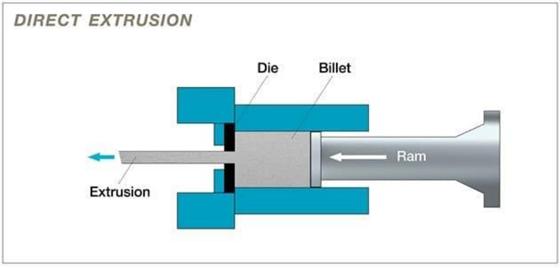
Direct Aluminum Extrusion
This is the most commonly used extrusion aluminum technique. The aluminum extruder places the billet/heated aluminum in a container with heated walls while a moving ram pushes the metal through the die opening with force. This step produces a high amount of pressure.
In addition, machinists usually put material blocks between the heated aluminum (billet) and the ram, preventing them from coming in contact. Most suppliers and manufacturers call this technique a direct/forward extrusion process because the aluminum and the ram move forward in the same direction.
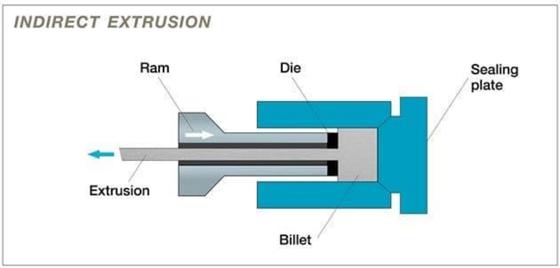
Indirect Aluminum Extrusion
Indirect or backward extrusion is entirely different from the direct technique. In this process, the heated aluminum and the container move concurrently while the die remains in the same position. Machinists often use a “stem” to perform this operation. The length of the stem must be longer than the container’s length. Hence, the stem forces the aluminum billet through the stationary die.
The backward extrusion generates less friction compared to the direct extrusion technique. It has a better heat control feature. This outcome may be a result of the applied force, which is relatively steady. Also, the consistent temperature ensures better grain structure and mechanical characteristics. As a result, the product quality for indirect extrusions is typically dependable.
What Shapes Can Be Extruded?
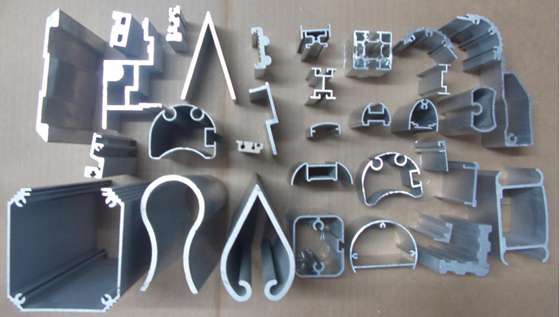
The aluminum extrusion process has limitless capabilities regarding shapes available in various specifications and sizes. Extrusion is integral to several industries; this makes it pretty challenging to list all its types. The main categories of extrusion include:
- Hollow Shapes: shapes such as tubes or profiles with varying cross-sections (i.e., rectangles, circles, squares, etc.)
- Semi-Solid Shapes: such shapes include channels, angles, and other partly opened shapes.
- Solid Shapes: This includes solid bars and rods with different cross-sections. (i.e., squares, circles, rectangles, etc.)
- Custom Aluminum Extrusion Shapes: These types of shapes usually have multiple extrusions. Also, they could be interlocking shapes with several color profiles. These shapes are precise to the designer’s specifications.
A Stepwise Guide to the Aluminum Extrusion Process
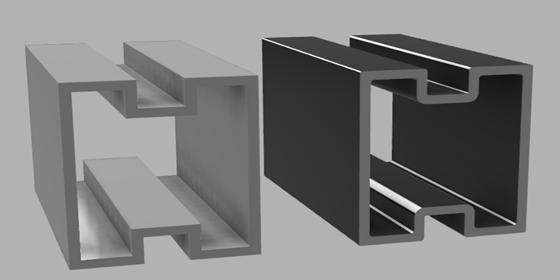
Step 1: Prepare Extrusion Die
The first step is to make a round-shaped die or use an existing one if available. Preheat the die to precisely 450-500ᵒC before initiating the extrusion process. This helps to ensure that the metal passes through evenly and maximizes the die’s longevity. You can load the die into the extrusion press after the preheating procedure.
Step 2: Pre-Heat Aluminum Billet
The next thing is to cut the cylindrical billet from a stretched log of material, then preheat the billet in an oven to 400-500ᵒC. This technique prepares the billet, making it malleable for the operation. It ensures that it is not molten.
Step 3: Move the Billet to the Extrusion Press
Transfer the billet into the press mechanically after preheating it. However, add lubricant to it before filling the billet into the press. In addition, ensure to put a release agent to the extrusion ram. Consequently, this helps to prevent the billet and ram from joining together.
At this point, the malleable billet is ready in the extrusion press. Here, the hydraulic ram can apply precisely 15,000 tons of pressure. This pressure forces the malleable billet into the container. The aluminum material stretches till it fills the container’s walls.
Step 4: Press-up Extruded Material Against the Die
The aluminum material that fills the container’s walls gets pressed against the extrusion die. You need to apply pressure to the material continuously. Hence, the extruded material emerges through the die opening fully formed.
Step 5: Quench the Extrusion
A puller grasps the extrusion, holding it in place after exiting the press. It safeguards the extrusion as it leaves the press while the alloy undergoes a “quenching” process as it moves along the table. The profile cools off evenly with a full water bath or fan.
Step 6: Shear the Extrusion to the Table Length
Once the aluminum extrusion makes the total table length, use a hot saw to shear it. However, note that temperature is essential at each step of the extrusion method. Despite the quenching process, the extrusion is not always fully cooled off yet.
Step 7: Cool Extrusion to Room Temperature
After completing the shearing process, move the extrusions to a cooling plain from the runout table. The profiles remain there till they achieve room temperature. As soon as they reach room temperature, stretching begins.
Step 8: Transfer Extrusions to the Stretcher and Stretch Them into Alignment
At this stage, you will discover certain twists in the shape of the extruded aluminum that needs correcting. It would help if you had a stretcher to repair these twists. Hold each profile manually at different ends while pulling them till they are entirely straight. This procedure helps to adjust the extrusion to the desired specification.
Step 9: Transfer Extrusion to the Finish to the Finish Saw and Cut Them to Length
At this stage, when the extrusions are fully straightened and work hardened, you can now move them to the saw table. The next thing is for you to cut the extrusions into desired lengths. These lengths are usually between 8-21 feet. Move these extrusions to the oven for aging to the proper temper (T6 or T5) after completing the sawing process.
Step 10: Carry Out Secondary Operations (Heat Treatment, Fabrication, & Surface Finishing)
Upon completion of the extrusion process, you can enhance the properties of these profiles by treating them with heat. After the heat treatment, consider fabricating the extrusions if there are dimensions that need correction. In addition, adding surface finishes helps to enhance the aesthetic appearance and corrosion resistance properties of the extruded aluminum.
What Factors Affect the Extruded Aluminum?
Although the above-explained extrusion steps of the aluminum extrusion process may appear easy and automated, these steps can be very complicated. The extrusion process is quite complex and depends on the relationship between numerous parameters that must be managed. They include the following:
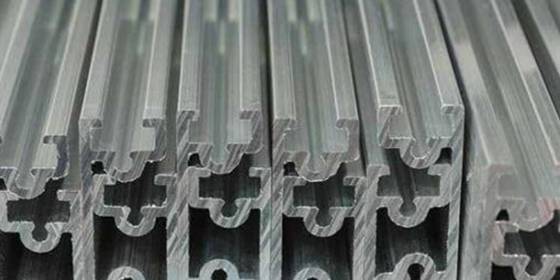
1. Extrusion Speed
In general, the extrusion speed is directly proportional to the temperature inside the container and the metal pressure. To maintain a stable process and provide a constant extruded segment, the speed, temperature, and pressure must be suitably correlated.
2. Extrusion Ratio
Any shape’s extrusion ratio is an indicator of the amount of mechanical work that will be done during the extrusion process. When the extrusion ratio of a section is relatively low, there will be minimal mechanical work on the areas of the shape involving the largest metal mass. When the extrusion ratio is high, on the other hand, more pressure is required. The pressure is to force the metal through small openings.
3. Billet Temperature
The ideal billet temperature provides suitable surface conditions and acceptable tolerances. Likewise, it ensures the shortest possible cycle time. It is always preferable to have the lowest possible temperature for the billet extrusion. Too high temperatures will cause the metal to flow more freely. The metal might resist entering confined areas. Thus, the shape dimensions may fall outside of the specified tolerances. Similarly, high temperatures can cause the metal to rip at thin edges and sharp corners.
4. Extrusion Press
Weight per foot becomes important in the extrusion of aluminum due to the different extrusion presses. Extruding lighter portions, as expected, requires smaller presses. However, there are also other issues that may necessitate larger capacity presses.
A common example is a bigger, thin-walled hollow extrusion shape. Despite having a low weight per foot, the extrusion press tonnage required may be greater. The effect is similar to that of the extrusion ratio. A higher factor makes the part more difficult to extrude. As a result, this has an impact on press production.
5. Extrusion Shapes
The shape determines the complexity and costs of extruding a component. The aluminum extrusion process can create a wide variety of shapes, but it has some restrictions. Simple solid shapes, for example, will be considerably easier, faster, and less expensive to extrude than semi-hollow shapes. The more complicated the shape, the more difficult and expensive it is to extrude.
After the successful completion of the extrusion and quenching processes, you also need to carefully and closely monitor these parameters:
- Dimensions and tolerances of the product
- Macro-structure of the bars/tubes/profiles
- Surface finish
- Mechanical properties
- Other special quality considerations
Available Post-treatment Options for Extrusion Aluminum
The post-treatment options for extruded profiles help to improve their properties. These are some of these options:
Metal Heat Treatment Processes
To improve their ultimate tensile strength and yield stress, you can heat-treat aluminum alloys in the 5000, 6000, and 7000 series. To do this, you must put these profiles in ovens where they are quickly aged.
Mechanical Machining
Mechanical machining of extruded aluminum is not a single process; it involves a collection of methods that help enhance the aluminum extrusion’s surface. These include cutting, polishing, sanding, and grinding. Unlike chemical applications, you have to use abrasive media to apply mechanical force to the surface of the aluminum to smoothen it. It helps to enhance its surface in preparation for another finishing operation.
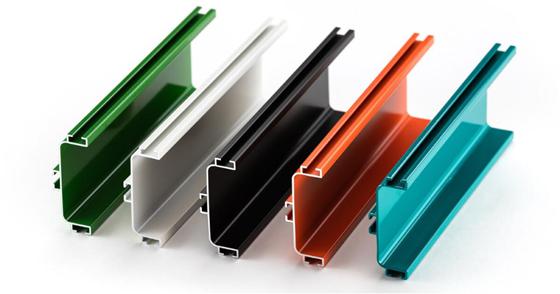
Surface Treatment
Aluminum bars can take different finishing treatments. This helps to enhance the appearance of these extruded profiles and their corrosion properties.
●Anodizing
Anodizing is a process that helps strengthen the aluminum’s naturally-existing oxide layer. It does this by improving its corrosion resistance properties. Also, anodizing aluminum makes the metal more resistant to wear, strengthening the surface emissivity and creating a porous surface that can accept various colored dyes.
●Painting
Manufacturers often paint extrusions for aesthetic reasons. However, it also helps to increase its longevity and reduce the cost of maintenance. You can also apply different colors to extruded aluminum profiles, providing a buffer against corrosion.
●Blasting
Blasting helps to eliminate residue and scale present on a machined component after heat treatments. This procedure helps to add texture to the surface while removing other contaminates that may remain after heat treatment. Blasting helps to make further operations, such as machining and painting, easier, giving your extruded aluminum profiles an aesthetic matte finish.
Advantages and Disadvantages of Aluminum Extrusions
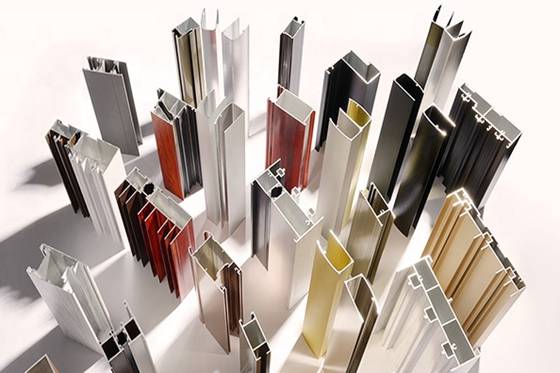
Most manufacturers prefer the aluminum extrusion process to other production processes because of their extraordinary combination of toughness and lightness. However, aluminum extrusion has more advantages from the industry perspective. Here are some of these advantages:
- Extruded aluminum is typically rigid and stronger.
- Low industrial cost.
- High flexibility of operation.
- They are usually an economical and competitive manufacturing option for handling complex cross-sections.
- Extruded products have a perfect surface finish and are stronger than those made using cast aluminum.
However, it is essential to note that aluminum extrusion has some disadvantages despite its enormous advantages.
- Aluminum extrusions are generally limited by the capacity of the steel container on the extrusion press.
- The extrusion die is often subjected to harsh working conditions like high temperature and friction, making it easily worn out. This generally affects the strength and lifespan of the mold.
Applications of Extruded Aluminum Parts
The material qualities render aluminum extrusion an effective and efficient manufacturing process for many industries. The material’s tensile strength and strength-to-weight ratio make it perfect for extruding transmission housings, chassis for vehicles, engine blocks, and many other essential parts.
Extruding aluminum plays a vital role in producing nuclear reactors, cooling devices in electronics, air conditioners, and condenser tubes. Extruded aluminum has non-magnetic properties making them suitable for house wires, coaxial cables, and aluminum enclosures.
In addition, this aluminum material’s corrosion and rust-resistance properties make it ideal for outdoor applications. It is important to note that aluminum extrusions have high reflective properties. As a result, they are excellent for shielding products from infrared radiation, light, and radio waves.
Custom Low-Volume Extruded Aluminum Parts at WayKen
If you need a reliable manufacturer to help you manufacture low-volume extruded aluminum parts, WayKen is the right shop to visit. We offer high-quality aluminum extrusion fabrication for quality components with excellent corrosion and wear resistance properties.
Our team of professional engineering and advanced technology make us deliver custom aluminum extrusion and other aluminum machining services. Also, we offer various surface finish options for your final products. Just Contact us today and let WayKen meet all your machining needs.
Conclusion
Aluminum extrusion is an economical production process that helps to fabricate different products with varying shapes. This process helps manufacture different simple or complex shapes with excellent product properties. You can create 8-24 foot long profiles which can be fabricated, heat-treated, and given finishing options to best fit your product specification. However, you should follow the extrusion steps and design tips carefully to get the best results.
FAQs
Which aluminum alloys are suitable for extrusion?
The aluminum 6063 is ideal for the extrusion process. However, the 6061 is usually stronger. So, if strength is a primary requirement for an application, the 6061 is the suitable choice between the two.
What factors affect aluminum extrusion costs?
The critical factors influencing the aluminum extrusion costs are die and tooling costs, current aluminum costs, labor and production costs, surface finishing and secondary operations, and production volume.
Which aluminum is better for extrusion between 6061 and 7075 aluminum?
Both aluminum alloys are suitable for extrusion as they are heat-treatable. The 6061 aluminum is better for extrusion due to its high thermal conductivity. Although the 7075 is much stronger than the 6061, it melts quickly at a lower temperature.

